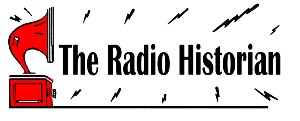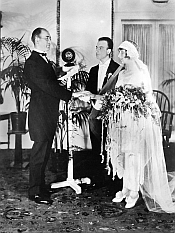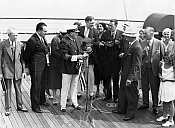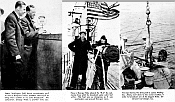|
www.theradiohistorian.org
Copyright 2017 -
John F. Schneider & Associates, LLC
[Return
to Home Page]
(Click
on photos to enlarge)
Viola Clark and Seth Jacobs are married in a live broadcast over WPG, Atlantic City 1925.
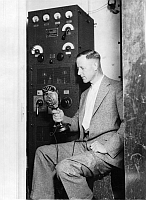
NBC engineer Joe Baker
mans the shortwave transmitter used to broadcast the "Ship of Joy"
program from the SS Malolo.
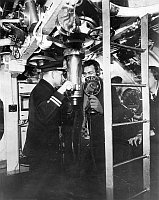
NBC's George Hicks broadcasts live from a Navy submarine, 1930.
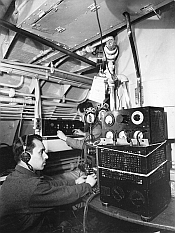
This
NBC shortwave transmitter in another Navy submarine broadcast George
Hicks' voice to WEAF in New York, and then on to the NBC network.
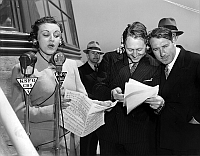
Jane
Kaye sings "There's a Goldmine in the Sky" over KSFO in 1939,
accompanied by the Nighthawks band flying overhead in an airplane.
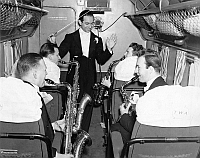
Jan Savitt leads the "Top Hatters" while flying 5,000 feet over
Philadelphia in a two-way broadcast on KYW - April 29, 1937.
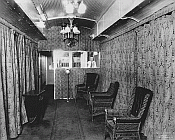
Portable station WHBL broadcast a live program from the Pioneer Limited
as it traveled from
Chicago to Minneapolis, 1927.

Shortwave
bridge game played via General Electric's shortwave station W2XAF in
Schenectady, NY, April, 1935. C.H. Lang (L), manager of publicity and
broadcasting, and John D. Lockton (R), GE's assistant treasurer, play
against a team in Barranquilla, Colombia.
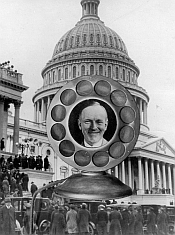
The March, 1925, inauguration of Calvin Coolidge was broadcast over a
national chain of stations,
reaching 25 million people.
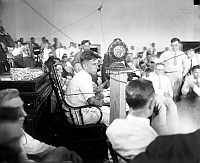
Chicago's WGN broadcast the Scopes
Monkey Trial live from Dayton, Tennessee in 1925.
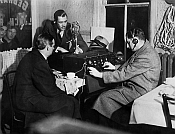
NBC broadcasts news of thekidnapping of Charles Lindbergh’s infant son
from Hopewell, NJ, 1932.
L-R: E.C. Wilbur, engineer; Ed Thorgerson,
announcer; W.R. Brown, engineer.
|
|
INTRODUCTION
In the beginning years of radio
broadcasting, the thrill of
hearing live sounds – any sounds – through the air from distant
locations was
enough to keep audiences enthralled.
But
as the novelty wore off and the typical third-rate radio concerts of
sopranos
with piano accompaniment became commonplace, radio stations and the
early
networks looked for novel and sometimes flamboyant programs and stunts
that
they could broadcast to their listeners.
Thus began a continual series of “radio firsts” that
became frequent
occurrences during broadcasting’s first two decades.
Not unlike modern attempts to make it into
the Guinness Book of World Records,
early stations sought new ways to make “radio history” by transmitting
something that had never been heard before.
This ranged from broadcasts of important and
monumental events, to
arcane and quirky stunts that served no purpose but to entertain and
fascinate.
GETTING "HITCHED" VIA RADIO
One
of radio’s first popular stunts was the “radio
wedding”.
The
earliest recorded marriage
by radio actually took place in 1920, when a bride in Detroit married a
seaman
on the Navy cruiser Birmingham, in
the middle of the Pacific.
The
wedding
vows were exchanged via telephone from Detroit to Chicago, and then
over a Navy
radio station to the ship.
KDKA
broadcast one of the first radio weddings to a general audience in
November,
1922.
By 1924 radio
weddings transmitted
by local stations had become a common occurrence, but the biggest event
took place
on June 4, 1924 - the marriage of Wendell Hall, “the Red-Headed Music
Maker”,
to newspaperwoman Miss Marion Martin.
Hall was a well-known singing recording artist, and
early radio star,
and also the host of “The Eveready Hour”, which originated at WEAF in
New York,
and was rebroadcast over an early pre-NBC network hookup consisting of
WCAP,
WJAR and WGN. The
wedding took place in
the WEAF studios, and was heard by an estimated 4 million listener
“witnesses”.
Although the
wedding was a publicity
stunt for the station, the marriage was a success, as the couple stayed
married
the rest of their years.
There
were all kinds of radio stunts heard in the first few
years of broadcasting.
Guest
broadcasts
by animals were commonplace, such as KHJ’s interviews with a chimpanzee
and a
cockatoo in 1923.
In
1924, KDKA wanted
to demonstrate the sensitivity of its latest Westinghouse microphone;
and so on
April 5 it broadcast the sound of a human heartbeat and the first radio
kiss.
Also
in 1924, WTAM held an
open-air dance for the public under its broadcast antenna in Cleveland.
Guests danced to the music
of the Ev Jones
Dance Orchestra, as heard through headphones attached to individual
crystal
radio receivers.
In
1925, WGR in
Buffalo brought its microphone to Niagara Falls to make a live
broadcast of the
sound of the waterfall.
In
1926, WJAS in
Pittsburgh transmitted a telephone conversation with a girl flagpole
sitter
atop the Fort Pitt hotel in Pittsburgh.
That same year, KLO in Ogden, Utah, broadcast the
live birth of the
first baby of the New Year from Dee Hospital.
RADIO ON THE HIGH SEAS
The
first commercial radio program to be broadcast from a
ship on the high seas took place from July 11 to 23, 1931, when NBC
broadcast
its daily West Coast program, the “Shell Ship of Joy”, from a
specially-constructed studio on the Matson linear Malolo, en route from
San
Francisco to Honolulu. The
entire cast
of the program, led by the host, “Captain” Hugh Barrett Dobbs,
performed on the
deck of the ocean liner for each morning’s broadcast.
The programs were sent by shortwave to KPO in
San Francisco, where they were relayed on to the rest of the network.
Broadcasts
from underneath the sea were also heard.
On December 7, 1930, NBC’s George Hicks
broadcast from a Navy submarine underwater in Long Island Sound.
In the live broadcast, he
described the
vessel as he traversed it from bow to stern, interviewing the captain
and crew
along the way.
The
audio of the
broadcast was sent through a cable suspended from another sub on the
surface,
where announcer James Wallington in turn relayed the program
by shortwave to NBC studios
in New York.
The
next year, the stunt
was repeated on the West Coast, heard over KJBS in San Francisco during
the
Navy Day celebrations from San Francisco Bay.
In 1924 and 1925, station WIP sent an announcer in a diver's
suit
off the end of the Steel Peer in Atlantic City for live broadcasts.
And in 1932, William Beebe broadcast live from a
bathysphere as he was
lowered 2,200 feet below the surface near Bermuda.
RADIO IN THE SKY
Broadcasting
from the skies was another early stunt tried by
several stations.
The
first reported case
of a broadcast made from an airplane took place in Detroit on October
9, 1922. During
the National Airplane Races, a flying boat, the "Wilber Wright", flew
above the event and broadcast a running commentary.
The plane carried a 50-watt transmitter, but
it broadcast directly to the crowd on 590 kHz, and was not relayed by
any
broadcast station.
At
first, aircraft motor noise and the poor quality of early
microphones caused lighter-than-air craft to become the preferred
vehicle.
In 1923,
KSD in St. Louis broadcast a two-way
conversation with a dirigible in flight.
Then a three-way conversation was heard in 1926 over
WTAM in Cleveland -
between an airborne dirigible, the roof of the Hotel Allerton, and the
Goodyear
plant in Akron. In
1925, WGY in
Schenectady used an airplane to broadcast a race between a speed boat
and the
New York Central's Twentieth Century train between Albany and New York.
Also that year,
WCCO chief engineer Hugh
McCartney broadcast a solar eclipse from a Minnesota State Guard plane,
high
over Minneapolis.
Stratosphere
balloon ascents were big news in the early
thirties, and so high altitude broadcasts were the subject of a number
of
broadcasts.
In
1932, Professor Auguste
Piccard broadcast an after-the-fact description by shortwave of his
ten-mile
ascent over Switzerland in a stratosphere balloon. Then in 1933, WTAM
broadcast
an ascent by a Navy balloon, and in 1934 the Army broadcast part of the
way
during a balloon ascent, although they had to throw their radio
equipment
overboard to lighten the load after they reached 61,000 feet.
The following
year, NBC broadcast another
ascent that made it up to 72,000 feet.
Broadcasting
musicians who were connected by radio from
different locations was also tried. In 1936, KUOA in Siloam Springs,
Arkansas,
broadcast a quartet singing from their studios, accompanied by
musicians in
Fayetteville, some 30 miles distant.
Then in 1939, KSFO in San Francisco broadcast an
aerial musical stunt as
a part of the Golden Gate Exposition.
An
airplane flying over the expo grounds carried musicians of the
Nighthawks band,
who played “There’s a Goldmine in the Sky” into a radio microphone from
the
heavens while singer Jane Kaye sang the lyrics from the ground.
RADIO RIDES THE RAILS
Radio’s
flirtation with the railroads began in October,
1922, when station KSD in St. Louis broadcast a musical program to
passengers
of a moving train.
In
1927, WHBL
reversed the process by equipping a railroad car with a transmitter and
studio,
and broadcasting a live program from the Pioneer Limited as it raced
from
Chicago to Minneapolis.
And
finally in
1932, the railroads went live on the CBS network, as the program “The
Eveready
Radio Gaieties” broadcast from a converted dining car on a B&O
train as it
travelled at speeds of up to 70 MPH from Washington to New York.
Receivers were
set up in two different Maryland
cities to pick up the shortwave signals from the train and send them on
to New
York via phone lines for broadcast over the network.
GOING THE DISTANCE
Early
listeners were always fascinated by hearing radio
signals from far-away places, and the broadcasters were always happy to
accommodate
them.
In 1923, KHJ
in Los Angeles picked
up and rebroadcast a program received over the air from KGU in Honolulu.
In 1925, WGY in
Schenectady broadcast a
bridge game between players in its studio and another team 6,000 miles
away in
Buenos Aires.
WGY
also aired a
long-distance stunt in 1928 when it broadcast a three-way conversation
between
its studio, Australia and Java.
And
then there were broadcasts that originated
underground.
In
1937, WHIS in West
Virginia broadcast live from the bottom of a coal mine.
In 1944, KOA in
Denver went 4,100 feet below the Continental Divide and eight miles
underground
when it broadcast from the trans-continental water diversion tunnel.
One
of the most ambitious long-distance broadcasts took
place starting in 1933, when CBS aired a weekly series of programs from
the
South Pole during Admiral Byrd’s expedition to Little America.
To facilitate the program,
CBS installed a
1,000 watt shortwave station, KFZ, at the South Pole, broadcasting from
a
prefabricated building that served as both a radio studio and living
quarters
for the staff.
The
KFZ programs were
picked up by a high powered Argentine shortwave station and
re-transmitted to
the network in New York. They featured weather reports from Little
America,
expedition reports and an interview with Byrd.
The programs usually closed with conversations
between family and
friends in New York and the explorers Little America.
Amateur radio and shortwave enthusiasts
sought out the KFZ signals with enthusiasm, and there were many reports
of its
reception in the U.S. on the early shortwave bands.
BROADCASTS OF IMPORTANT NEWS EVENTS
Not
all of these early broadcasts were publicity
stunts.
Radio also
took advantage of its
unique “on the scene” abilities to broadcast many of the important news
events
of the day.
Starting
with KDKA’s 1920
broadcast of the Harding-Cox presidential election returns, radio
demonstrated its
superiority over newspapers as a news medium, thanks to its immediacy
and ability
to place its listeners directly at the scene of great events.
One
of radio’s first event programs was the broadcast of the
Jack Dempsey-Georges Carpentier boxing match from Jersey City, NJ, on
July 21,
1921.
The broadcast
went out over WJY, a
special station set up by RCA for a single day to broadcast the boxing
match.
The
temporary transmitter was set
up in the Lackawanna railroad yards, with an antenna suspended over the
railroad tracks.
At
ringside, Major
Andrew J. White described the fight into a telephone connected to the
railroad
yards, where Owen White repeated them to the audience of an estimated
300,000
persons.
The fight
ended with Dempsey
knocking out Carpentier in the fourth round, which was fortunate
because the
transmitter overheated shortly afterwards and was knocked off the air.
The
first broadcast of a sitting U.S. president was heard
over WEAR in Baltimore in 1923, as Warren G. Harding dedicated the
Francis
Scott Key Monument at Fort McHenry.
And Woodrow
Wilson broadcast a speech later that year, shortly after his retirement
from
the White House.
When
Harding died
unexpectedly during a trip to the West Coast, his funeral was heard
live over a
multi-station hookup, and then speeches by his successor, Calvin
Coolidge, were
heard regularly over temporary regional station hookups.
After his reelection for a
second term, his
inauguration in March of 1925 was broadcast over a national chain of
stations,
reaching an estimated audience of 25 million.
This
all took place before the establishment
of the formal radio networks, which led to Franklin Roosevelt’s famous
“Fireside Chats” les than a decade later.
One
of the most important broadcasts of a news event, as
seen in its historical context, was the broadcast all eight days of the
Scopes
Monkey Trial from Dayton, Tennessee over WGN in Chicago in 1925.
The station obtained
permission to rearrange
the courtroom layout to facilitate its microphones, and it leased
long-distance
telephone lines at a cost of $1,000 a day so that listeners around the
Midwest could
hear the daily arguments between Clarence Darrow and William Jennings
Bryan.
Unfortunately,
recording
technology was still in its infancy in 1925, and so no recordings of
the
historic broadcast were ever made.
Radio
was in the middle of the action on April 21, 1930,
when CBS broadcast an eyewitness account from inside the walls of the
Ohio
State Penitentiary as a disastrous fire took the lives of 318 people.
Then in 1932, radio
reporters descended on
Hopewell, NJ, to transmit the daily occurrences surrounding the “crime
of the
century”, the kidnapping of Charles Lindbergh’s infant son.
After the kidnapping
suspect, Bruno
Hauptmann, was captured in 1935, networks and local stations alike
broadcast
daily reports from his trial from Flemington, NJ, and then of his
subsequent
execution in 1936.
Radio
was again on the front lines on May 6, 1938, when WLS
announcer Herb Morrison described the crash of the German dirigible
Hindenburg
at Lakehurst, NJ. Morrison and engineer
Charlie Nehlsen had been
assigned by WLS to make an experimental recording of the routine
arrival of the
airship.
In an
extreme case of being in
the right place at the right time, a little-known radio announcer was
suddenly
thrust into the national spotlight as he described the horrific fiery
crash
into his microphone.
The
acetate
recording disks were flown back to Chicago and broadcast later that
night.
The next
day, portions were broadcast over
the NBC network – reportedly the first time the network broke its “no
recordings” policy.
The
famous recording
of that event still raises the hair on the back of peoples’ necks to
this day.
GUSHING WITH PRAISE FOR RADIO
Finally,
to tell one more story about radio’s early
broadcasts of unusual events, we offer you the live broadcast of the
opening of
a new oil well by KWKH in Shreveport in 1935.
The Lawton Well No. 1, an exploratory well in
Rodessa, Louisiana, was
about to be completed, and the KWKH wanted to broadcast the event.
But the nearest telephone
was found to be
located in a party line in a sharecropper’s cabin, more than three
miles away
from the wellhead.
The
station talked
with the cabin owner, who agreed to let them his phone line, and the
other
party line users all agreed to stay off their phones during the
broadcast.
And so,
KWKH engineers laid several miles of bare
iron wire through pine trees, over fences and across cotton fields in
order to
get their signal back from the event.
Announcers
Jack Keasler and Jack Geizer then stationed themselves at the well site
and
waited all day for the work to be completed.
When the well finally started flowing, it proved to
be an enormous
gusher, and KWKH broadcast a live description with the sounds of a
gushing well
of an event that would prove to be an economic boon to the region for
several
years.
BIBLIOGRAPHY:
- The
First Quarter Century
of American Broadcasting by E.P.J.
Shurick, 1946
- “Radio
News” magazine,
December 1922: “The First Airplane Broadcasting Station”
- “Radio”
magazine, May 1922: “Married
by Radio”
- “Popular
Radio” magazine,
August 1924: “How
it Feels to be Married
by Radio”
- “Brooklyn
Daily Eagle”, Dec.
8, 1930, pg. 19: “Aboard
U. S.
Submarine”
- "Radio
Digest", July 1925: "Broadcasts from Ocean Bed Via
Land Line"
- “Radio
News” magazine, July,
1934: “Listening to
Byrd on Shortwave
Radio”
- “Broadcast
Weekly” magazine,
June 28, 1931: “Shell
Happytime to Present Unique
Broadcast Series”
- "Battle of
the
Century": The WJY Story by Thomas H. White
http://earlyradiohistory.us/WJY.htm
- “Arcane
Radio Trivia” website,
Sept. 18, 2009: “First
Submarine
Broadcast”
- “RCA
Broadcast News”, April
1932: “Broadcast
from Speeding Train”
- “Radio
Aspects of the
Lindbergh Kidnapping” by Jack French, 2008
- “Popular
Mechanics” magazine,
September, 1924: “Radio
Wedding”
- “Chicago
Tribune”, March 22,
1964: “WGN in
Monkey Trial”
- Wikipedia: Herbert Morrison; Wendell
Hall
- “Broadcasting”
magazine, Sept.
15, 1935: “Gusher
broadcast”
NOTE:
This article appeared in the Spectrum Monitor Magazine, June, 2017
www.theradiohistorian.org
John F. Schneider & Associates, LLC
Copyright, 2017
|



